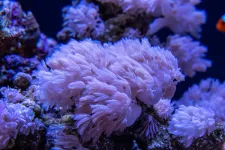(Press-News.org) Doctors are one step closer to having a risk biomarker to alert them to which of their pediatric stem cell transplant patients are likely to experience a potentially deadly side effect called sinusoidal obstruction syndrome (SOS).
A team led by MUSC Hollings Cancer Center researcher Sophie Paczesny, M.D., Ph.D., published the results of its biomarker study in JCI Insight this month.
There is a drug, defibrotide, approved to treat SOS. Paczesny hopes the results of the biomarker study will encourage defibrotide’s manufacturer to conduct a multicenter clinical trial testing whether giving it to patients who test positive for the risk biomarkers before they begin to show symptoms can prevent SOS from developing.
“That’s my dream. These patients really need it,” she said. “Most of my colleagues on this study are physicians, so they really want me to move this forward because they still see a lot of patients being affected by this.”
Stem cell transplants can cure blood cancers and other blood disorders, but, as with other cancer treatments, they come with side effects.
SOS, sometimes called hepatic veno-occlusive disease, means that the veins in the liver are blocked. It's not the most common side effect after an allogeneic hematopoietic cell transplant, or a stem cell transplant using donor cells: that would probably be graft-versus-host disease, which is the main focus of Paczesny’s research. But SOS occurs in a significant number of patients – 12.5% in this study – and can lead to multiorgan failure and death.
In addition, it can be harder to diagnose in children than in adults, and there are no clear risk factors that indicate who is likely to develop this condition, Paczesny said. Previous studies have looked at proactively giving defibrotide to all patients, but those studies showed no clear benefit, she said. The drug is also rather expensive, so limiting it to those who would truly benefit makes sense.
In a previous study, Paczesny’s team gathered samples from children who developed SOS and identified potential biomarkers based on either unusually high or unusually low levels. Those potential biomarkers included ST2, a receptor that is also used as a biomarker of cardiac stress; hyaluronic acid, best known as an anti-aging ingredient in skin care products but also a component of connective tissue that’s used as a biomarker of liver fibrosis; and L-ficolin, a protein expressed in the liver that plays a role in the innate immune system.
In this study, conducted at four academic medical centers across the country, the researchers wanted to see at what point the potential risk biomarkers would start showing unusual levels. They tested 80 patients’ plasma at two points in time: three days after the stem cell transplant and seven days after the stem cell transplant. SOS typically occurs within a month of transplant, so those two points in time would presumably give doctors enough time to act. And, in fact, the researchers found that measuring those biomarkers on day three following the transfer of hematopoietic cells did indicate which patients would go on to develop SOS.
“Using the combination of the three biomarkers as a score, recipients with a positive score were 9.3 times more likely to develop SOS,” they reported.
Patients with positive scores were also more likely to die within 100 days of the transplant.
The researchers noted that this study appeared to be the first prospective biomarker analysis for donor stem cell transplant.
Besides identifying patients at risk of SOS, the biomarkers could possibly also be used to monitor how well patients respond to treatment with defibrotide. If a study with a larger group shows that the biomarkers are effective trackers, then doctors could use them to decide when the patient no longer needs defibrotide, rather than giving everyone the same 21-day treatment.
About MUSC Hollings Cancer Center
MUSC Hollings Cancer Center is South Carolina’s only National Cancer Institute-designated cancer center with the largest academic-based cancer research program in the state. The cancer center comprises more than 130 faculty cancer scientists and 20 academic departments. It has an annual research funding portfolio of more than $44 million and sponsors more than 200 clinical trials across the state. Dedicated to preventing and reducing the cancer burden statewide, the Hollings Office of Community Outreach and Engagement works with community organizations to bring cancer education and prevention information to affected populations. Hollings offers state-of-the-art cancer screening, diagnostic capabilities, therapies and surgical techniques within its multidisciplinary clinics. Hollings specialists include surgeons, medical oncologists, radiation oncologists, radiologists, pathologists, psychologists and other clinical providers equipped to provide the full range of cancer care. For more information, visit hollingscancercenter.musc.edu.
END
Risk biomarkers could predict serious side effect of stem cell transplant
2023-05-22
ELSE PRESS RELEASES FROM THIS DATE:
First Contact: Global team simulates message from extraterrestrial intelligence to Earth
2023-05-22
First Contact: Global team simulates message from extraterrestrial intelligence to Earth
A Sign in Space imagines how Earth might respond to a signal from aliens and invites the public to help decode an ET message.
May 22, 2023, Mountain View, CA – What would happen if we received a message from an extraterrestrial civilization? Daniela de Paulis, an established interdisciplinary artist and licensed radio operator who currently serves as Artist in Residence at the SETI Institute and the Green Bank Observatory, has brought ...
GPR141 regulates breast cancer progression via oncogenic mediators and the p-mTOR/p53 axis
2023-05-22
“This research uncovers GPR141 as a stimulator of breast tumorigenesis and metastasis, making it a candidate target for breast cancer therapeutics.”
BUFFALO, NY- May 22, 2023 – A new research paper was published in Oncotarget's Volume 14 on May 19, 2023, entitled, “G-protein-coupled receptor 141 mediates breast cancer proliferation and metastasis by regulating oncogenic mediators and the p-mTOR/p53 axis.”
Breast cancer morbidity is surging towards the peak in females across the globe. An inherent property of cancer cells is enhanced cell proliferation rate and migration capability, leading to deregulated cell ...
Study highlights long-term benefits of family-based care following institutional care
2023-05-22
SAN FRANCISCO, May 22, 2023 – New research, published online today in the American Journal of Psychiatry, provides the most robust and comprehensive evidence to date that children exposed to early psychosocial deprivation benefit substantially from family-based care. Senior author Kathryn L. Humphreys, Ph.D., discussed this work today at a special briefing during the 2023 Annual Meeting of the American Psychiatric Association.
Results of research from the Bucharest Early Intervention Project, the ...
Corals mark friendly algae for ingestion—revealing possible conservation target
2023-05-22
Baltimore, MD—New research led by Carnegie’s Yixian Zhen and Minjie Hu reveals how coral cells tag friendly algae before ingesting them, initiating a mutually beneficial relationship. This information could guide next-level coral conservation efforts.
Their work is published in Nature Microbiology.
Corals are marine invertebrates that build large exoskeletons from which reefs are constructed. But this architecture is only possible because of a mutually beneficial relationship between the coral and various species of single-celled algae called dinoflagellates ...
WVU researchers see need to strengthen mental health programs for first responders
2023-05-22
Controlling traumatic situations is synonymous with the daily duties of first responders, yet many mental health programs to combat the increasing stress they encounter are lacking. That’s why West Virginia University researchers are identifying steps policymakers and community members can take to aid front-line workers.
“With elevated risk for suicide and other mental health issues among first responders, we have a significant public health problem,” said Michael Fisher, assistant professor in the WVU School of Public Health ...
Study may explain why high-sugar diets can worsen IBD
2023-05-22
Excess sugar hampers cells that renew the colon’s lining in a mouse model of inflammatory bowel disease (IBD), according to a new study by University of Pittsburgh scientists.
The findings, published in Cellular and Molecular Gastroenterology and Hepatology, could help get to the bottom of why limiting sugary foods can ease symptoms for patients with IBD.
“The prevalence of IBD is rising around the world, and it’s rising the fastest in cultures with industrialized, urban lifestyles, which typically have diets high in sugar,” said senior author Timothy Hand, Ph.D., associate professor of pediatrics and immunology at Pitt’s ...
Identifying the bee’s knees of bumble bee diets
2023-05-22
COLUMBUS, Ohio – A new study has identified the bee’s knees of bumble bee dietary options in Ohio and the Upper Midwest.
By viewing almost 23,000 bumble bee-flower interactions over two years, researchers found that these bees don’t always settle for the most abundant flowers in their foraging area – suggesting they have more discerning dietary preferences than one might expect.
Being large, strong and social bees that can fly for long distances, bumble bees are major contributors to pollination, particularly for agriculture – but like other pollinators threatened by habitat ...
TAp63: A new protein drug target for rheumatoid arthritis
2023-05-22
Rheumatoid arthritis (RA) is an autoimmune disease characterized by joint deterioration. The clinical outcomes of patients with active RA can be improved using anti-rheumatic medications, such as methotrexate (MTX). Many patients rely on MTX to limit the destructive joint damage and functional disability typical of RA. Although the drug is a folic acid antagonist, its precise mechanisms in RA patients are largely unknown.
Previous research suggests that MTX also affects a type of white blood cell called CD4+ T cells. These cells are believed to play a role in the development of RA—specifically, the balance between the activation of interleukin-17-producing helper T ...
Weigel receives funding for infrastructure development, maintenance and outreach for Heliophysics Application Programmer's Interface (HAPI)
2023-05-22
Robert Weigel, Professor, Physics and Astronomy, received funding for: "Infrastructure Development, Maintenance, and Outreach for the Heliophysics Application Programmer's Interface (HAPI)."
Weigel will facilitate HAPI adoption by upcoming missions by providing targeted instrument team support.
He will create additional HAPI server reference implementations.
He will create a meta-server to facilitate an integrated HAPI ecosystem.
He will create higher-level services that build on the uniformity afforded by HAPI ...
Fossils of a saber-toothed top predator reveal a scramble for dominance leading up to “the Great Dying”
2023-05-22
Two hundred and fifty-two million years ago, Earth experienced a mass extinction so devastating that it’s become known as “the Great Dying.” Massive volcanic eruptions triggered catastrophic climate change, killing off nine out of every ten species and eventually setting the stage for the dinosaurs. But the Great Dying was a long goodbye-- the extinction event took place over the course of up to a million years at the end of the Permian period. During that time, the fossil record shows drama and upheaval as species fought to get a foothold in their changing environments. One animal that exemplifies ...







